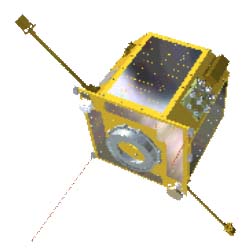The 6 small satellites will be launched onboard the H-IIA rocket in summer 2008, Japan
From 2008, JAXA will use the opportunity of the H-IIA launch to give commercial industries, universities and other organizations a chance to launch small satellites (between 1 kg and 50 kg). JAXA will share the experiences and technologies relating to orbit demonstration that will be gathered by the commercial industries and universities. JAXA aims to expand future applications of space development by using small satellites in Japan, and contribute to education in universities and nurture talented persons.
As the first step, last year JAXA took applications for small satellites that could be placed onboard the H-IIA rocket, to be launched from 2008. JAXA's selection committee screened the 21 group applications received, and this May selected six groups whose small satellites will be launched onboard the H-IIA rocket in summer 2008.
JAXA Industrial Collaboration Department held a “Joint Workshop on Small Satellites” in the Metropolitan Industry and Trade Center in Hamamatsu-cho, Tokyo, Japan on July 23, 2007. The meeting room had a capacity of 80 people and was already full before the workshop started. The six chosen groups each gave a presentation on their small satellites and had enthusiastic question and answer sessions with the participants.
An overview of each of the six satellites chosen by JAXA's selection committee this May is shown below.
These satellites are all in the initial stages of development using a flight model toward next year's launch.
| 1. Space Oriented Higashiosaka Leading Association (SOHLA) | |
|---|---|
|
(A group of small- to medium-sized businesses in Osaka Prefecture) |
|
| Satellite name: | SOHLA-1 |
| Size: | 50 cm ?? 50 cm ?? 50 cm |
| Mass: | 50 kg |
| Attitude control: | Spin-stabilized |
| Main purpose: | To invigorate regional industries by developing useful satellites |
| Mission: |
|
| 2. Tohoku University | |
|---|---|
|
|
|
| Satellite name: | Sprites and TGF observation satellite (SPRITE-SAT) |
| Size: | 50 cm ?? 50 cm ?? 45 cm |
| Mass: | 47 kg |
| Attitude control: | Gravity-gradient stabilized + 2 magnetic torquers |
| Main purpose: | To perform leading-edge research, albeit with a small satellite |
| Mission: |
|
| 3. SORUN CORPORATION | |
|---|---|
|
|
|
| Satellite name: | KAGAYAKI* (*KAGAYAKI means brilliancy inJapanese) |
| Size: | 30 cm ?? 30 cm ?? 30 cm |
| Mass: | 20 kg |
| Attitude control: | Gravity-gradient stabilized +2 magnetic torquers (1 axis) |
| Main purpose: | To connect the dreams of handicapped children with space |
| Mission: |
|
| 4. University of Tokyo | |
|---|---|
|
|
|
| Satellite name: | PRISM |
| Size: | 20 cm ?? 20 cm ?? 25 cm |
| Mass: | 5 kg |
| Attitude control: | Gravity-gradient stabilized + 3magnetic torquers (3 axis) |
| Main purpose: | To serve as a first attempt at applying nano-satellites to practical missions |
| Mission: |
|
| 5. Kagawa University | |
|---|---|
|
|
|
| Satellite name: | STARS |
| Size: | 20 cm ?? 20 cm ?? 40 cm (when the daughter satellite is docked with the mother) |
| Mass: | Mother satellite 3.6 kg, daughter satellite 3.4 kg |
| Attitude control: | 2 magnetic torquers on each satellite |
| Main purpose: | To verify the technologies of a tethered space robot anddeliver photos of an orbiting satellite to all over the world |
| Mission: |
|
| 6. Tokyo Metropolitan College of Industrial Technology | |
|---|---|
|
|
|
| Satellite name: | KKS-1 |
| Size: | 15 cm ?? 15 cm ?? 15 cm |
| Mass: | 3 kg |
| Attitude control: | 3 momentum wheels |
| Main purpose: | To educate students |
| Mission: |
|





